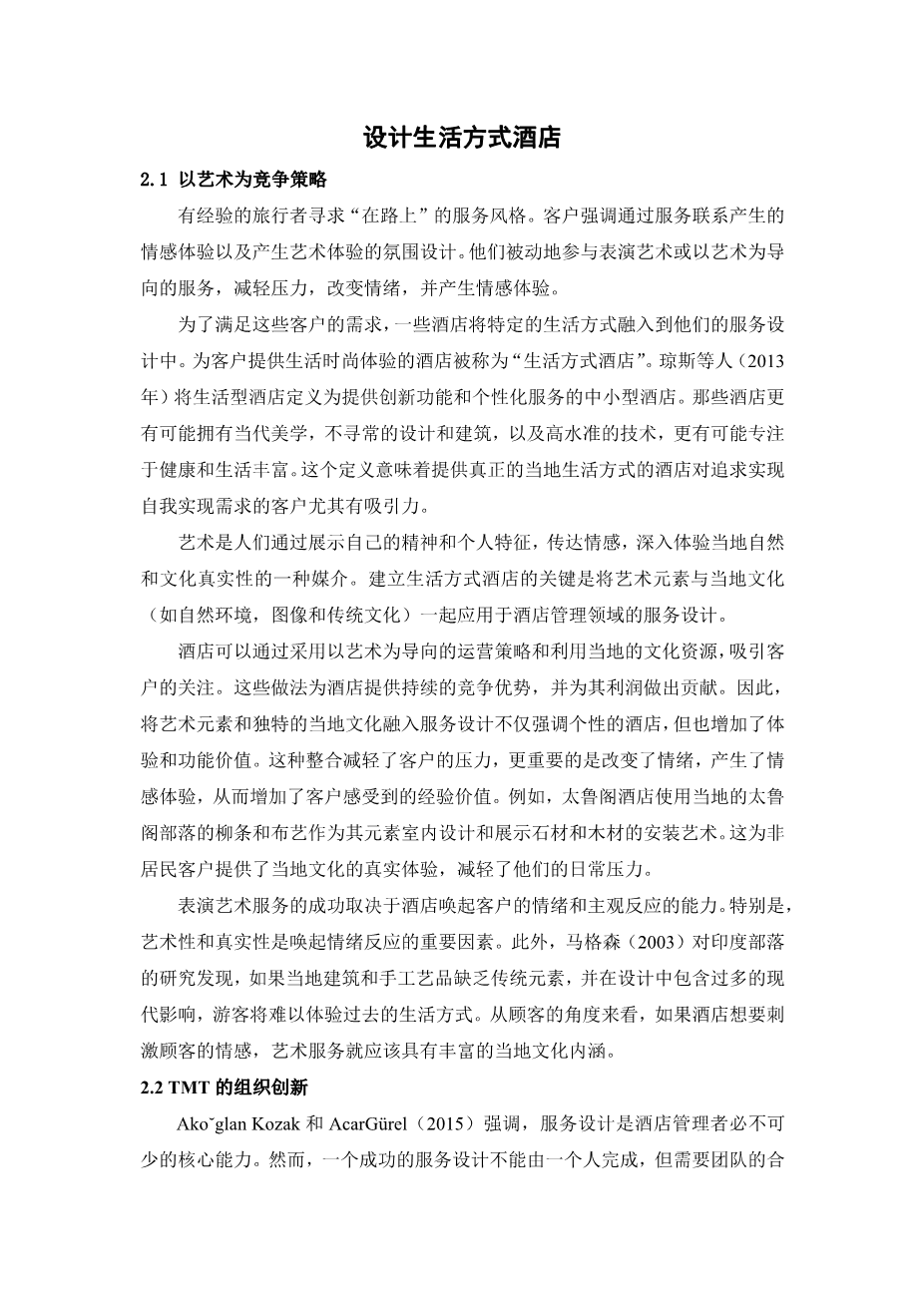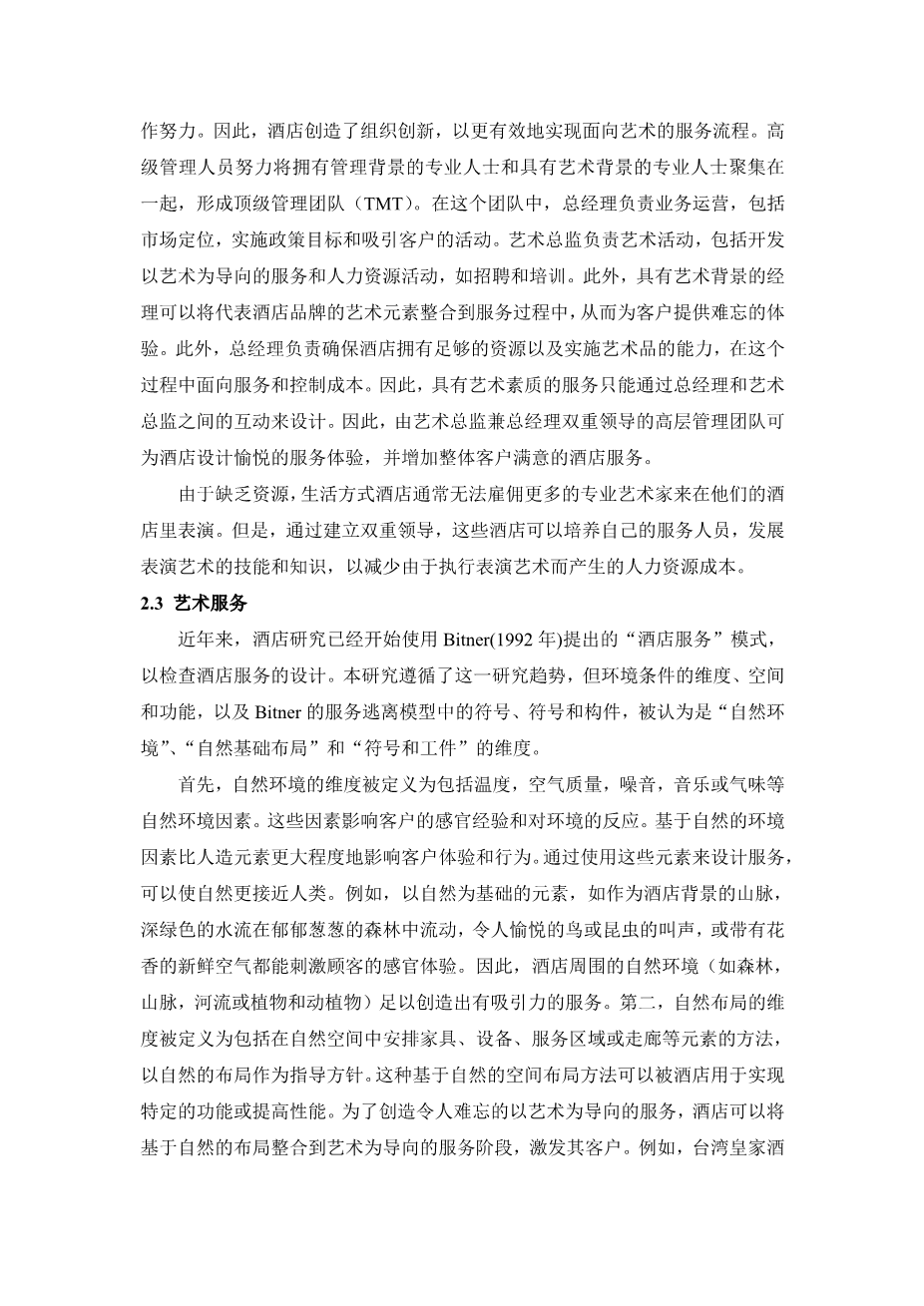设计生活方式酒店外文翻译资料
2023-08-01 10:06:05
Designing lifestyle hotels
2.1. Using art as a competitive strategy
Experienced travelers seek an “on the road” style of service. Customers emphasize the emotional experiences produced through service contacts and the ambience design that generates art experiences. Their passive participation in performing arts or art-oriented services relieves stress, alters their moods, and produces an emotional experience .
To satisfy the needs of these customers, some hotels have integrated elements of a particular lifestyle into their service designs. Hotels that offer customers life-stylize experiences are called lifestyle hotels. Jones et al. (2013) defined lifestyle hotels as small to medium sized hotels that provide innovative features and personalize service. Those hotels are more likely to have contemporary aesthetics, unusual designs and architecture, and high-level technology, and they are more likely to focus on wellness and life enrichment. This definition implies that hotels that offer immersion into an authentic local lifestyle are especially attractive to customers who pursue the fulfillment of self-actualization needs.
Art is a medium that people adopt to exhibit their spiritual and individual characteristics, to convey affection, and to deeply experience local nature and cultural authenticity. The key to establishing lifestyle hotels is applying art elements with local culture (e.g., natural environment, images, and traditional culture) to service designs in the hotel management field.
Hotels can attract customer attention by adopting art-oriented operational strategies and leveraging local cultural resources. These practices provide hotels with a sustained competitive advantage and contribute to their profits. Because, integrating artistic elements and unique local cultural into a service design not only emphasizes the individuality of a hotel but also increases its experiential and functional value. This integration relieves stress among customers, but more crucially, it alters their moods and produces emotional experiences, thereby increasing the experiential value perceived by customers.For example, Leader Village Taroko hotel uses wicker and cloth crafts of the local Taroko tribe as elements of its interior design and displays stone and wood installation art. This provides nonresident customers with an authentic experience of indigenous culture and relieves their daily stress.
The success of performing arts services was determined by abilities of hotels to evoke emotional and subjective responses of customers. In particular, artfulness and authenticity are important factors to evoke emotional responses. In addition, Magelssenrsquo;s (2003) researching upon Indian tribes discovered that if local architecture and handicrafts lack traditional elements, and contain excessive modern influences in their design, tourists will have difficulty experiencing past lifestyles. From customer orientation perspective, artistic services should be richly endowed with authentic, local cultural content if hotels try to stimulate emotions of customers.
2.2. Organizational innovation of TMT
Ako˘ glan Kozak and Acar Guuml;rel (2015) emphasized that service design is a core ability necessary in hotel managers. However, a successful service design cannot be completed by a single person but requires the cooperative efforts of a team. Thus, hotels create organizational innovations to more effectively implement art-oriented service processes. Senior executives strive to bring together professionals with manage backgrounds and professionals with performing art backgrounds to form the top management team (TMT). Within this team, the managing director is responsible for business operations, including market positioning, implementing policy objectives, and activities to attract customers. The artistic director is responsible for artistic operations, including developing art-oriented services and human resources activities such as recruitment and training. Furthermore, managers with an art background can integrate artistic elements that represent the hotelrsquo;s brand into the service process, thus delivering memorable experiences to customers. In addition, the managing director is responsible for ensuring that the hotel has sufficient resources as well as the ability to implement art-oriented services and control costs during this process. Thus, services with artistic qualities can only be designed through interactions between the managing director and artistic director. Therefore, the top management team that is dual leadership by an artistic director and a managing director can design pleasurable service experiences for the hotel and increase overall customers satisfaction with the hotelrsquo;s services.
Due to a lack of resources, lifestyle hotels are usually unable to hire additional professional artists to perform in their hotels. But, through building dual leadership, those hotels can train their own service employees to develop skills in and knowledge of performing arts so as to reduce human resources costs incurred due to the execution of performing arts.
2.3. Artistic servicescape
In recent years, hotel research studies have begun using the ser-vicescape model proposed by Bitner (1992) to examine the design of hotel servicescapes. The present study followed this research trend, but the dimensions of ambient conditions; space and function; and signs, symbols, and artifacts in Bitnerrsquo;s servicescape model were conceptualized as the dimensions of “natural-based environment”, “natural-base layout”, and “signs and artifacts”.
First, the dimension of natural-based environment was defined as including elements of the natural environment, such as temperature, air quality, noise, music, or odors. These elements affect customersrsquo; sensory experiences and their reaction to the environme
剩余内容已隐藏,支付完成后下载完整资料


英语译文共 4 页,剩余内容已隐藏,支付完成后下载完整资料
资料编号:[613811],资料为PDF文档或Word文档,PDF文档可免费转换为Word




